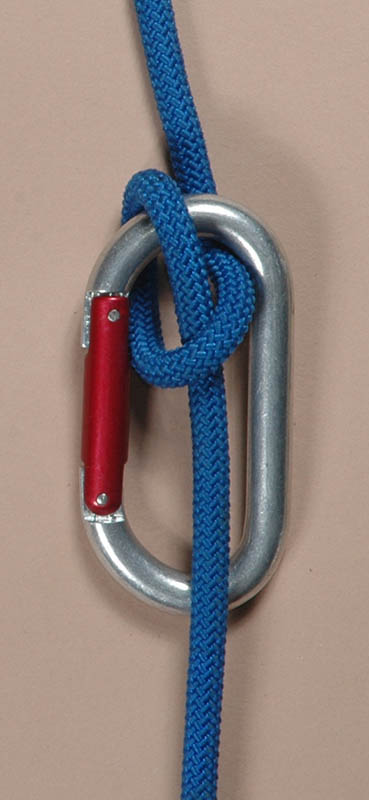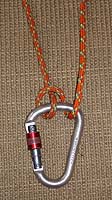 One
of the best methods for belaying with climbing ropes doesn't require
any additional device at all. The Munter Hitch was chosen as the
U.I.A.A. method of choice ages ago, and is still considered to
be an excellent method. For many years I avoided it because it
has nylon running on nylon, but I now use it at times. It doesn't
work as well on stiff caving rope as it does on climbing line,
but then again, those ropes shouldn't be used for belaying any
lead climbs.
One
of the best methods for belaying with climbing ropes doesn't require
any additional device at all. The Munter Hitch was chosen as the
U.I.A.A. method of choice ages ago, and is still considered to
be an excellent method. For many years I avoided it because it
has nylon running on nylon, but I now use it at times. It doesn't
work as well on stiff caving rope as it does on climbing line,
but then again, those ropes shouldn't be used for belaying any
lead climbs.
The Munter Hitch should be rigged as shown in the main figure,
so that the load is on the spine side of the carabiner. Of course,
you should use a locking carabiner (preferably HMS type). The
Munter Hitch tends to "walk" to one side of the carabiner;
placing the load on the spine side causes it to walk toward the
spine (replacing the carabiner with an Edelrid
Frog avoids the issue). The Munter Hitch can be inverted to
feed rope in the other direction, in which case it takes on the
form shown in the small figure to the right.
Anyone using a Munter Hitch for belay should make sure they
know the Munter-Mule combination. I won't go into the details
here because this is something on which one should get proper instruction.
The Munter Hitch can also be used as an emergency rappelling
rig, although there are better carabiner
rappel options available.
Johannes Haas sent me the following comments on my description:
 I do believe that you give some wrong, or at least questionable
information on your page about the Munter hitch.
both your pictures show the brake rope pointing downwards. The first
problem with that is the fact that the rope is running over the gate of
the carabiner. You suggest using a locker (which of course is a good
suggestion), but there are concerns that the rope running over it can
unscrew the locking mechanism.
I do believe that you give some wrong, or at least questionable
information on your page about the Munter hitch.
both your pictures show the brake rope pointing downwards. The first
problem with that is the fact that the rope is running over the gate of
the carabiner. You suggest using a locker (which of course is a good
suggestion), but there are concerns that the rope running over it can
unscrew the locking mechanism.
Another problem with the brake rope pointing down is that the brake
force is reduced, compared to a brake rope up orientation.
Further, if lowering a person (or rappelling) the rope pointing downwards
will introduce a lot of twists into the rope (I believe this wrong
operation of the Munter is among the reasons why it has such a bad
reputation in America). Of course having the brake hand pointing
downwards is easier (and it is what one is probably used to, from tubes/
slotted devices), especially when using the Munter to lower or rappel,
but from my observation it is worth the hassle to have the brake hand
pointing upwards (like in the attached picture HMS1).
All this is supported by various books. The two I have at reach now are
"Hoffman M. (2006) Sicher Sichern, Sportklettern Eis Big Wall. Panico
Alpinverlag" and "Geyer P. and Dick A. (2001) Alpin- Lehrplan Band 3,
Hochtouren Eisklettern. BLV Verlagsgesellschaft mbH."
It seems like there are some older publications that show a similar
orientation of the ropes to yours when using the Munter to belay a
leader directly from the anchor (Schubert P. (1998) Die Anwendung des
Seiles in Fels und Eis. Bergverlag Rudolf Rother) but unfortunately this
book does not go into further details.
So to conclude: The Munter will work in the orientation shown on your
page, but due to the reasons pointed out above the orientation with the
braking strands upwards is the preferred one.
I sent the following reply:
You bring up at least two points. The first is whether the brake rope points up (your picture) or down (mine). I'm not advocating one over the other, the stance, anchors, etc. will often dictate which way is more natural. I'm certainly not teaching one way or another in my site, and only an idiot learns to climb by surfing the web.
The other point is whether the brake rope is on the gate or spine side of
the carabiner. My picture shows the arrangement shown in John Long’s "How to
Rock Climb!," 2nd edition, page 105; Larry Penberthy’s article in the August
1974 issue of Off Belay, and Off Belay’s summary of the UIAA belaying report
in the October 1974 issue.
Johannes also sent me some scans from the books that he referred to. As I look at the pictures, the book by Hoffman seems to support putting the brake rope on the spine side. It is not clear to me, with my lack of German, whether the book by Geyer and Dick clearly states which way they prefer, but it seems to prefer having the brake rope on the gate side. The book by Schubert shows both ways. There seems to be some disagreement in the literature; my experience aligns with my original description.
Although many other carabiners work perfectly well, many people prefer to use an HMS carabiner. HMS abbreviates the German word “Halbmastwurfsicherung,” which means "half clove hitch belay" (literally, "half mast hitch protection"), i.e. "Munter Hitch."



 I do believe that you give some wrong, or at least questionable
information on your page about the Munter hitch.
both your pictures show the brake rope pointing downwards. The first
problem with that is the fact that the rope is running over the gate of
the carabiner. You suggest using a locker (which of course is a good
suggestion), but there are concerns that the rope running over it can
unscrew the locking mechanism.
I do believe that you give some wrong, or at least questionable
information on your page about the Munter hitch.
both your pictures show the brake rope pointing downwards. The first
problem with that is the fact that the rope is running over the gate of
the carabiner. You suggest using a locker (which of course is a good
suggestion), but there are concerns that the rope running over it can
unscrew the locking mechanism.